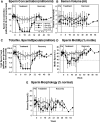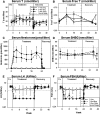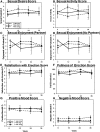A new combination of testosterone and nestorone transdermal gels for male hormonal contraception
- PMID: 22791756
- PMCID: PMC3462927
- DOI: 10.1210/jc.2012-1384
A new combination of testosterone and nestorone transdermal gels for male hormonal contraception
Abstract
Context: Combinations of testosterone (T) and nestorone (NES; a nonandrogenic progestin) transdermal gels may suppress spermatogenesis and prove appealing to men for contraception.
Objective: The objective of the study was to determine the effectiveness of T gel alone or combined with NES gel in suppressing spermatogenesis.
Design and setting: This was a randomized, double-blind, comparator clinical trial conducted at two academic medical centers.
Participants: Ninety-nine healthy male volunteers participated in the study.
Interventions: Volunteers were randomized to one of three treatment groups applying daily transdermal gels (group 1: T gel 10 g+NES 0 mg/placebo gel; group 2: T gel 10 g+NES gel 8 mg; group 3: T gel 10 g+NES gel 12 mg).
Main outcome variable: The main outcome variable of the study was the percentage of men whose sperm concentration was suppressed to 1 million/ml or less by 20-24 wk of treatment.
Results: Efficacy data analyses were performed on 56 subjects who adhered to the protocol and completed at least 20 wk of treatment. The percentage of men whose sperm concentration was 1 million/ml or less was significantly higher for T+NES 8 mg (89%, P<0.0001) and T+NES 12 mg (88%, P=0.0002) compared with T+NES 0 mg group (23%). The median serum total and free T concentrations in all groups were maintained within the adult male range throughout the treatment period. Adverse effects were minimal in all groups.
Conclusion: A combination of daily NES+T gels suppressed sperm concentration to 1 million/ml or less in 88.5% of men, with minimal adverse effects, and may be further studied as a male transdermal hormonal contraceptive.
Figures





References
-
- Martin CW, Anderson RA, Cheng L, Ho PC, van der Spuy Z, Smith KB, Glasier AF, Everington D, Baird DT. 2000. Potential impact of hormonal male contraception: cross-cultural implications for development of novel preparations. Hum Reprod 15:637–645 - PubMed
-
- Heinemann K, Saad F, Wiesemes M, White S, Heinemann L. 2005. Attitudes toward male fertility control: results of a multinational survey on four continents. Hum Reprod 20:549–556 - PubMed
-
- Glasier AF, Anakwe R, Everington D, Martin CW, van der Spuy Z, Cheng L, Ho PC, Anderson RA. 2000. Would women trust their partners to use a male pill? Hum Reprod 15:646–649 - PubMed
-
- Gu Y, Liang X, Wu W, Liu M, Song S, Cheng L, Bo L, Xiong C, Wang X, Liu X, Peng L, Yao K. 2009. Multicenter contraceptive efficacy trial of injectable testosterone undecanoate in Chinese men. J Clin Endocrinol Metab 94:1910–1915 - PubMed
Publication types
MeSH terms
Substances
Grants and funding
LinkOut - more resources
Full Text Sources
Other Literature Sources
Medical

